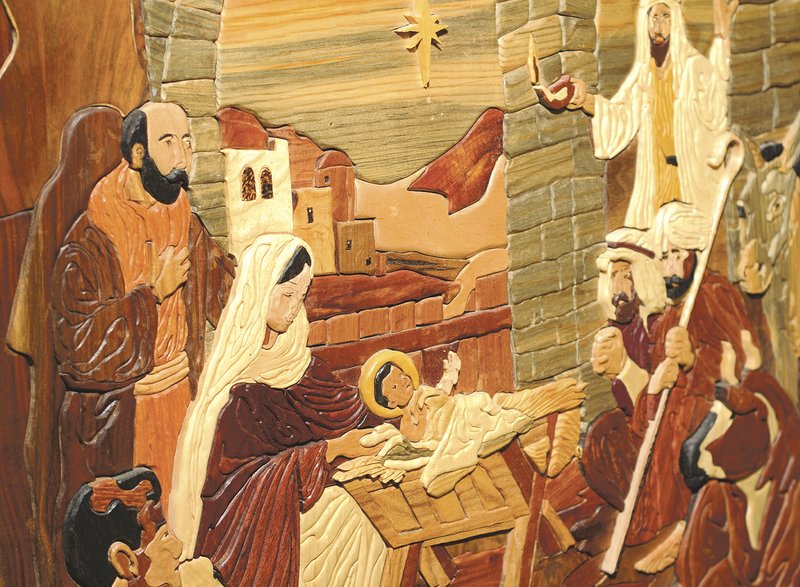Tommy Smith listed the many types of wood stored on the shelves of his Springdale workshop: aspen, cedar, yellowheart, purpleheart, honey locust, blood wood, mahogany, poplar ...
Each has its own color, its own grain. With pieces cut and put back together, Smith creates detailed, customized works of art in a process known as intarsia.
He uses various types of wood to create the color for his pieces -- no paint. "(The grain of) blue pine looks like bricks," Smith says. "A beetle causes (the wood) to change color. I get it from the state of Washington."
He mentions exotic woods -- like wenge from Africa and lignum vitae, which gives distant mountains streaks of color in his pieces.
"And sometimes, you get an ugly piece of wood, but you plane it, and it turns out good. You're lucky every once in a while," Smith says.
RENAISSANCE CRAFT
"I sometimes describe intarisa to people who have never seen it as 'stained glass out of wood,'" explains Bruce Worthington, founder of intarsia.net and Worthington House designs.
"Among the so-called 'minor arts' that flourished in the Italian Renaissance, perhaps the most astounding in its virtuosity was that of intarsia, or wood inlay, in which countless pieces of wood of various species were fitted together like a jigsaw puzzle so as to form exquisite pictures," reads a description of the book Renaissance Intarsia by Abbeville Press, recognized for its books on art.
"Intarsia is thought to have been developed in the 13th century Renaissance period in Siena, Italy," reads information provided by Worthington. "The process was derived from the Middle Eastern inlays of ivory upon wood. This art was widely practiced in Italy from c. 1400 to c. 1600."
The art declined but enjoyed a limited popularity in 18th century Japan, Imperial Rome, Egypt and Persia, Worthington continues.
Smith says the art is regaining popularity, thanks to patterns of Amish children by the Judy Gail Roberts Studio in Tennessee. In fact, Etsy-style Christmas markets set up in New York City parks this season feature several booths of intarsia work.
'FUN TO DO'
Smith -- retired from his printing brokerage and as the official scorer for the Razorback men's basketball team -- says he works about five hours a day, seven days a week on his hobby. Recently, he was working on bull riders -- six commissioned by a woman who saw Smith and his art at a fall crafts fair. He worked to make each bull rider unique by choosing various woods of different colors for the cowboys' clothes and hair. The project of six pieces will take him 15 to 20 days to complete, he estimates.
Intarsia patterns come on paper, with Smith cutting the individual pieces of the drawing apart. Next, he finds the color of wood he wants from planks cut down to a workable size. The paper pattern piece is laid over the piece of wood, and Smith uses a scroll saw, a band saw and different Dremel tools to shape the wood, depending on the pattern. "I buy blades a gross at a time," he says.
The Dremel tools add shape, depth and detail to the piece -- such as the folds in a bull rider's pants or feathers on an American Indian headdress. Smith also uses a wood burner, in this case to create lines on the rider's bull rope, eyelashes and mustache. A flap sander shaves the corner edges of a piece to a round shape to fit the pieces of this puzzle together again.
"It's so involved," Smith says.
A scene of the Nativity, which hangs in a Fort Smith church, took Smith 3 1/2 months to complete. A Lord's Supper scene -- measuring 5 feet by 4 feet -- includes more than 800 pieces, he says.
"I like religious pieces," Smith says. His family donated several to a nursing home in Fort Smith that cared for his sister. "Jesus was a carpenter. He helped (his father) Joseph -- even if Mary was telling them what to do," Smith adds with laughter.
Smith bought his first scroll saw in 1990. He had completed several pieces of fretwork when he saw his brother Hal creating in the intarsia form. "He said I need to try it," Smith remembers. "I made a (flying) eagle, and I was hooked."
Several different flying eagles line the walls of his family's living room, which offers a peaceful view of Beaver Lake and the eagles that soar above it.
Smith also makes model pieces from new intarsia patterns created by Worthington House in Brownstown, Mich. Pictures of Smith's works often appear in catalogs alongside the patterns.
"Tommy has always been good at the cutting, which is a great help in this type of woodwork," Bruce Worthington says. "Gaps between the pieces take away from the finished appearance. He has also been very good at the shaping of the pieces to give the three-dimensional effect we desire."
The two wood-inlay enthusiasts met through online groups devoted to the art. "Tommy has made some of my patterns and done a good job on them," Worthington continues. "Tommy is also good at doing the large pieces and is also fairly fast."
"It's fun to do," Smith says. "I can't hardly wait to get finished with one to see what it's going to look like. Nothing ever turns out the same."
Each piece is unique, and many are one -- or maybe two -- of a kind. Smith's wife Vicki often takes her pieces from the wall to give or sell to others. "I'll just have Tommy make me a new one," she says.
Those five hours a day when Smith works, his brain turns to what pattern he will tackle next -- not the troubles of the world.
"People getting shot -- that don't happen out here," Smith says of his workshop. "Although I do listen to Chet Atkins once in a while."
NAN Our Town on 12/03/2015

